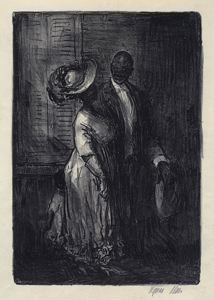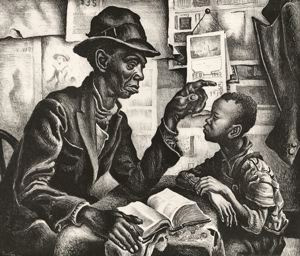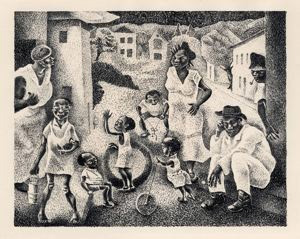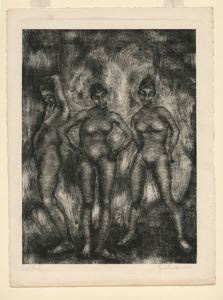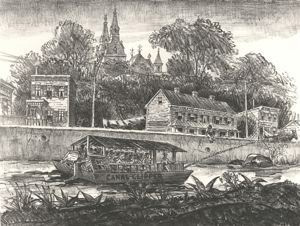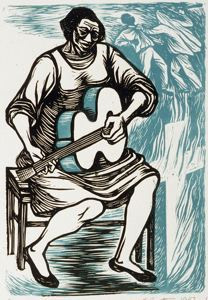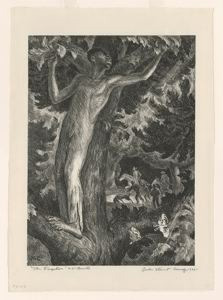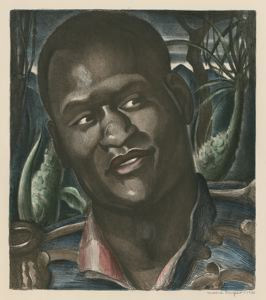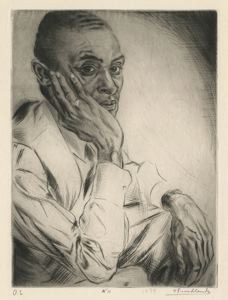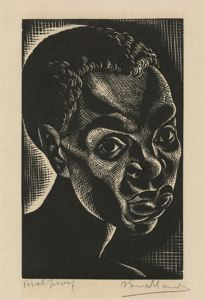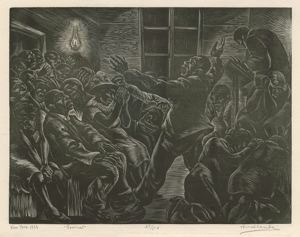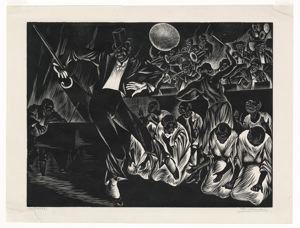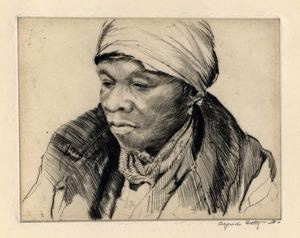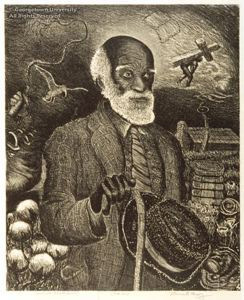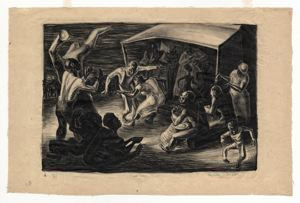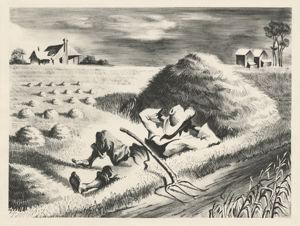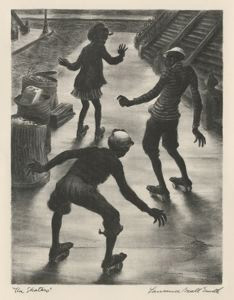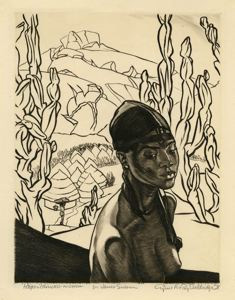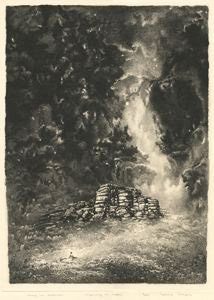An exhibition of fine prints for the opening of the fall term 1986.
Print collectors, whether they are building personal or institutional collections, are sometimes taken by surprise when they discover certain strengths emerging almost by indirection within their collections. These might include important holdings of given artists or schools, significant representations of the various techniques of printmaking, or certain classifications of imagery portrayed by the prints themselves. One such recent discovery here at Georgetown was the sweep and depth of prints dealing with the life and times of American blacks during the first half of the 20th century.
When the Washington Print Club chose figurative images by American graphic artists as the subject for its biennial members’ exhibition presently hanging at the National Museum of Art, Georgetown discovered that its holdings of figure prints of American blacks had grown significantly. As a result, the University is able to present “Black Figure Prints: Vignettes of an American Experience” as its 5th annual exhibition, i.e., portraits of blacks, followed by images of blacks in the work place, in religious observances, in social protest, and in leisure time pursuits.
Catalogue
The prints are listed alphabetically by artist and title. Dimensions are given in centimeters, height preceding width, and indicates size of image, i.e., plate or composition. An additional five prints are included in the exhibition, but appear at the end of the catalogue. Three of these are black figure prints of some interest, but the subjects are not American. The other two, while not black figure prints, are by two of America’s younger black printmakers whose work is represented in Georgetown’s collections.
Thomas Hart Benton (1889-1975)
Back from the Fields, 1945
Lithograph, ed. 250
24.7 x 32.6
Gateside Conversation, 1946
Lithograph, ed. 250
24.8 x 35.4
Instruction, 1940
Lithograph, ed. 250
26.5 x 31.3
Prayer Meeting, 1949
(halftone reproduction used by the artist as his Christmas Card)
22.7 x 31.3
George Biddle (1885-1973)
Catfish Row, 1936
American Artists Group
Lithograph, ed. 200?
24.2 x 30.6
Three Graces, 1926
Lithograph, ed. 100 – 1st. proof
32.0 x 23.8
Elizabeth Catlett (1919-2012)
Blues, 1947
Linocut, a/p I-VIII – no edition
18.5 x 9.8
Blues, 1947
Color linocut, ed. 35
18.8 x 12.8
Isac Friedlander (1890-1968)
Mr. O.S., 1939
Drypoint
30.1 x 22.7
Portrait of a Young Black, n/d
Wood engraving, ed. 50
17.8 x 11.1
Revival, 1933
Wood engraving, ed. 50
25.4 x 33.2
Rhapsody in Black, 1931
Wood engraving, ed. 50
23.9 x 31.9
Marion Greenwood (1909-1970)
The Fringed Scarf, 1946
lithograph, ed. 250
29.0 x 23.5
Mississippi Girl, 1945
lithograph, ed. 250
32.0 x 23.1
Joseph Hirsch (1910-1981)
Lunch Hour, 1942
lithograph, ed. 250
22.7 x 30.1
Man and Beast, 1946
lithograph, ed. 250
34.4 x 18.4
John McCrady (1911-1968)
The Robert E. Lee & The Natchez
lithograph
24.7 x 36.8
Swing Low, Sweet Chariot, 1941
Lithograph
27.7 x 37.7
Harry Sternberg (1904-2001)
Southern Holiday, 1935
lithograph, ed. 15
55.2 x 40.0
Lent by the artist
James Lesesne Wells (1902-1993)
African Fantasy, 1928
linocut
27.5 x 21.6
Lent by the artist
Builders, 1929
linocut
35.2 x 27.2
Lent by the artist
Factory Street, c. 1930
linocut, ed. 35
24.0 x 34.2
Lent by the artist
Flower Vendor - Georgetown, c. 1930
woodcut, ed. 30
24.6 x 33.5
Lent by the artist
Meyer Wolfe (1897-1985)
Baptism, 1934
lithograph, ed. 25
29.3 x 39.5
Tuesday - Othelia, 1934
lithograph, ed. 25
28.3 x 35.7
A Few More Prints
Cyrus Leroy Baldridge (1889-1975)
Pagan Princess - Nigeria, 1938
drypoint
27.6 x 21.1
Louis Legrand (1863-1951)
La Nigresse
drypoint, ed. 30
28.0 x 14.2
Agnes Tait (1897-1981)
Delphina, 1939
Lithograph
35.0 x 25.5
William Majors (1930-1982)
Burning Bush, 1967
etching, ed. 110
49.5 x 39.7
Norma Morgan (b. 1928)
Sharp Tor, Dartmoor
engraving, ed. 50
66.0 x 44.4
While the core of this exhibition has been assembled from the University’s permanent collections, it has been extended by the loan of five prints from two important American artists, Harry Sternberg of California, and Washington’s own James Lesesne Wells, who, prior to his retirement had taught printmaking for over forty years at Howard University. We are grateful to both of them.
We also wish to express our gratitude to Mrs. Gilda Friedlander for her continuing generosity in adding to Georgetown’s collection of her late husband’s work, four of which are in this exhibition, and to Chaim Gross for the recent gift of his 1968 lithograph, “M.L.K .Jr.”

